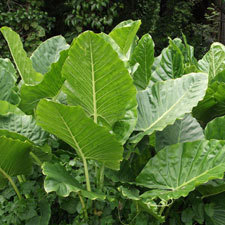 Elephant’s ear
Elephant’s ear
Common name: Elephant's ear
Botanical name: Alocasia brisbanensis
Management programme: Advisory
Originates from Ceylon, Tahiti, and Eastern Australia. Introduced to New Zealand as an ornamental garden plant. Large leaves have the appearance of an Elephant’s Ear, hence the name.
Why is it a pest?
- Elephant’s ear smothers the ground, preventing the regeneration of native species seedlings.
- Shades out natural ground cover.
- It readily recovers from heavy damage so can be difficult to control.
- It is poisonous and avoided by stock.
- Seed is spread by dropping near to parent plants, and occasionally through water dispersal.
- It can be spread through intentional planting as an ornamental garden plant, dumped vegetation, and soil movement.
Where is it found?
Found throughout the Bay of Plenty region. Elephant’s ear is usually found in damp or wet waste areas, generally in frost free habitats.
What does it look like?
- Large, long-lived, robust perennial up to 3m tall with a thick, fleshy rhizome and milky sap.
- Large, shiny, green, leathery, arrow-shaped leaves (80 x 50cm) with prominent veins.
- Fragrant creamy yellow spike of flowers (January to April) up to 6cm long, enclosed by a green boat-shaped bract, up to 15cm long. Scarlet to orange berries (10mm in diameter) contain 1–4 seeds.
- Stems are trunk-like on mature plants, with leaf scars and often have lower part of the trunk lying along the ground.
- Seeds drop near parent plants.
- Can be mistaken for Taro (Colocasia esculenta) which has smaller leaves on stalks with a reddish-purple tinge.
What are the rules?
Advisory
The Bay of Plenty Regional Council does not enforce the control of advisory species. It is landowner/occupier responsibility to manage these pests. Council may provide advice on how to manage or control these species if required.
How do you get rid of it?
Recommended:
- Hand pull small seedlings in high light areas.
- Stump treat:
- Slash vegetation off at ground level and treat fresh stumps with metsulfuron, glyphosate and penetrant mix (1g + 100ml + 20ml/ 1L water).
- Weed wipe (1g metsulfuron-methyl + 150ml glyphosate + 1ml penetrant/ 1L).
- Spray with a mix of 3g metsulfuron-methyl + 150ml glyphosate + 10ml penetrant per 10L water in spring or late autumn.
Digging is not a recommended control option as rhizome fragments can be left and plants will quickly regrow after slashing.
Follow up control will be required annually. All plant material can be disposed of at the refuse station in general waste.
CAUTION: When using any herbicide or pesticide, PLEASE READ THE LABEL THOROUGHLY to ensure that all instructions and directions for the purchase, use and storage of the product, are followed and adhered to.
Read more on pest control advice, information and regulations.
Images







